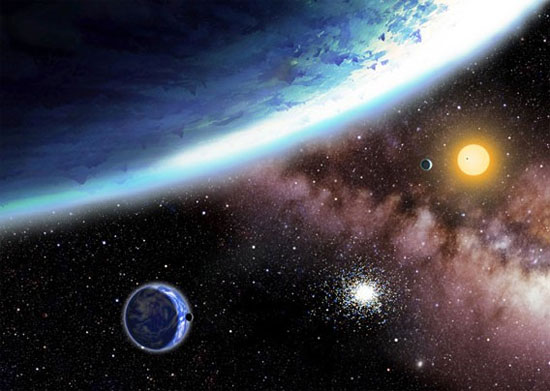The universe is full of earth
Although only discovered a few dozen candidates like the earth, scientists say the universe is likely filled with strange worlds that can support life.
According to the latest predictions, only the Milky Way could also contain about 60 billion planets of the 'Earth 2.0' version around red dwarfs that are emitting weak light. Previously, based on data given by the Kepler spacecraft specialized in hunting planets, scientists estimated there must be an earth-sized planet in the life support zone of each red dwarf star, the spectral star. The most variable across the universe.
However, a group of researchers has doubled this estimate after considering the cloud cover factor that could help a planet support life.'Clouds warm, and it also cools the earth,' Space.com quoted researcher Dorian Abbot, assistant professor at the University of Chicago. 'They reflect sunlight and calm things. They absorb infrared radiation from the surface and create a greenhouse effect. That's part of the process of keeping the planet warm enough for life to grow , 'he explained.

The science world is full of hope to find a second earth soon - (Photo: CfA)
The area that can nourish life is defined as the area where a planet has moderate temperatures to retain liquid water on the surface, which is thought to be a necessary condition for life. If the planet is too far away from the central star, the water will freeze, and too near the water evaporates. Because red dwarfs have softer and cooler light than our sun, life-sustaining areas are thought to be warmer than the sun's.'If you revolve around a dwarf or low density, a planet must make a journey once a month or once every two months to get enough light like the earth - the sun,' said Nicolas. Cowan of Northwest University. With such a trajectory, a planet will fall into a locked state, ie, only one face will return to the central star, just like how the moon is facing the earth. And this part will always be in the light of day.
In the new report, researchers use 3D models to look at how air and moisture move on a planet locked toward a red dwarf. They found that any source of water on the surface would turn into water clouds. And yet, these highly reflective clouds will form at sunrise. That phenomenon will create a cooling effect in the inner ring of the feeding zone, meaning that the planets will be able to maintain surface water at a much closer distance than the central star.
This finding could provide scientists with a new way of confirming the presence of liquid water on the surface of extraterrestrial planets with the help of James Webb Space Telescope (JWST). , an astronomical observatory will orbit in 2018. If JWST finds a cool signal on the daytime of an unfamiliar world, located near a red dwarf, it is an almost sure sign for see the presence of clouds, and of course there is liquid water, according to a report on the Astrophysical Journal Letters.
- Revealing the eradication moment of the Earth and the universe
- Marvel at the mighty universe
- Admire the biggest full moon of the year
- The Earth is not the center of the universe
- Full Moon facts - Full moon you may not know yet
- The things you do every day will become very 'weird' when you are in the universe
- 'Super moon' is about to appear
- 17 'truth' about the Earth and the universe is true but has been rejected by science
- Those who are lucky to see the earth from the universe, what do they think?
- The universe has many planets like Earth
- Blue moon and Mars together illuminate tomorrow night sky
- The moon is the brightest and brightest of the year
 Van Allen's belt and evidence that the Apollo 11 mission to the Moon was myth
Van Allen's belt and evidence that the Apollo 11 mission to the Moon was myth The levels of civilization in the universe (Kardashev scale)
The levels of civilization in the universe (Kardashev scale) Today Mars, the sun and the Earth are aligned
Today Mars, the sun and the Earth are aligned The Amazon owner announced a secret plan to build a space base for thousands of people
The Amazon owner announced a secret plan to build a space base for thousands of people